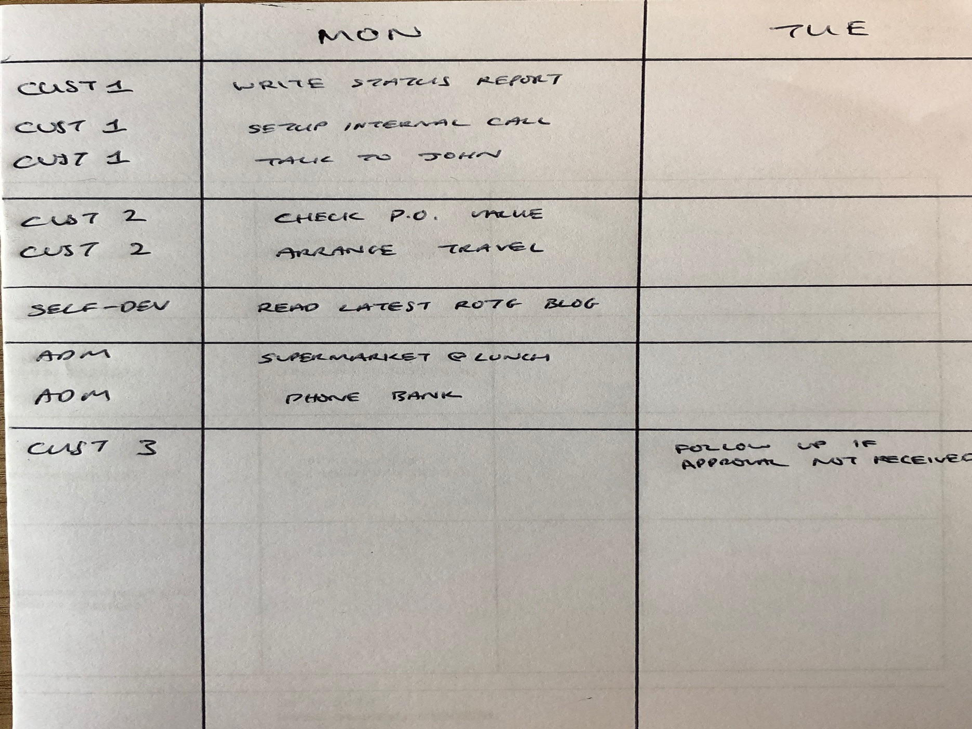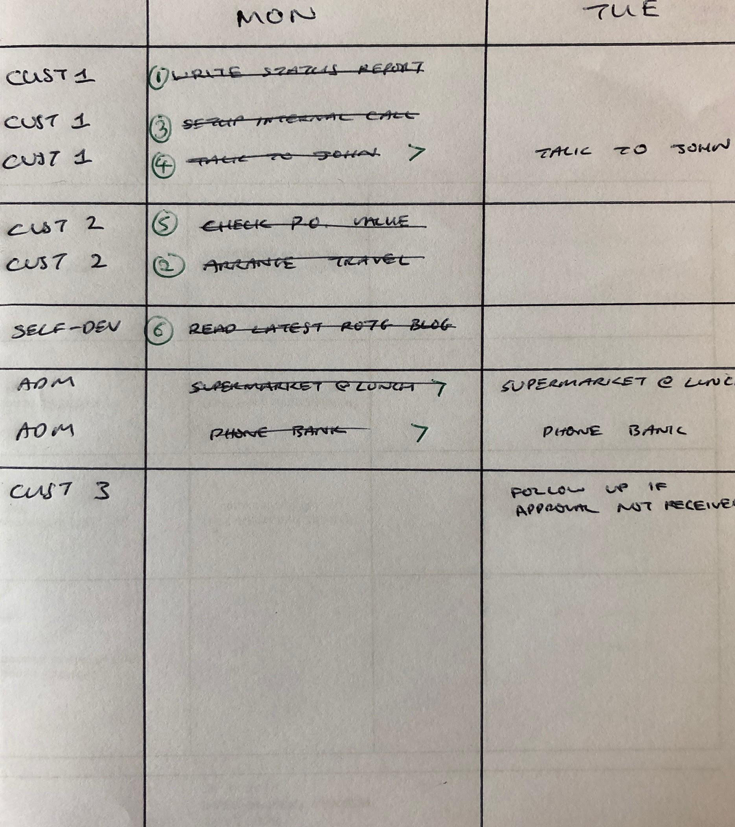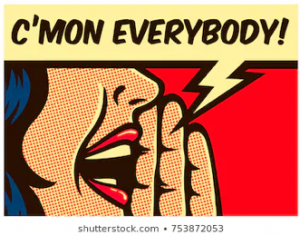How Do You (To) Do?
The humble to-do list - On the merits of keeping it simple
Like them or tolerate them, we all need to consider what task tracking system works best for us - from the classic paper-based “To Do” list right up to using the latest collaborative technology (Trello anyone?) or structured methodologies (Dave Allen’s GTD system is a long-standing servant for many).
As a coder and carefree youth who has evolved into a project manager and a, well, more responsibility-laden adult, I have experimented with multiple variations on the classic to-do list - varying frequency of look ahead & update (daily/weekly) , prioritising tasks (or not), time boxing tasks (or not), paper-based or electronic, online or offline and so on - I have found most variations and levels of complexity served their purpose to some degree at some point in time.
Although not seeking perfection, I have never settled on one that I could say I was truly happy with. Until now.
The following simple system (I hope you agree) has been working very well for me for some time now. Do let me know if there is something of value for you here too.
Its’ virtues are ease of use, flexibility and clarity.
Figure 1 - Example To Do List @ Start of Day (Monday)
 Features
Features
1 - Paper-Based. One A5 sheet (A4 folded in half does the trick). In my case, this is a loose sheet which I slip into my work notebook but it could be a page in the notebook itself or a dedicated book.
2 - Time Span of 2 days - today and tomorrow (or next working day). Day goes on the horizontal axis on top. Categories go on the left-hand vertical axis.
In this example, categories are specific work projects (CUST1 and CUST2), Self-development and Admin. The categories are repeated line by line because I find it a good visual indicator of the number of tasks per category (for me, the specific quantity matters less than a sense of their proportionality).
3 - Comprehensive - You will see there is a mix of the personal and professional, I find that this helps plan my day better by foreseeing all upcoming activities and actions and gives me a feeling (illusion?) of control of the personal on very busy professional days (and vice versa). If I have a 10-minute personal task I am more likely to carve out time to do it on a very busy day at work if it is on the list.
4 - Simple Notation - tasks that get done are crossed out, tasks that are partially done get a dot ⚫ after them and tasks that do not get done today get a
> after them, get crossed out and are moved to the next working day (by writing them again in that column).
This notation is based on
Ryder Carroll’s Bullet Journal method and I find the use of the
> is a key differentiator from the traditional list. You won’t feel the same sense of failure you may feel if a task on a classic to-do list is not done by crossing out and adding a
> as this is just rescheduling for tomorrow - it’s still on your radar and still on your plan and hence still in your control - you simply did not get to it today.
5 - Prioritization - Tasks are prioritized when they are a ‘Must’ or a ‘Should’ today. I use a different colour here for clarity and I will often prioritise for the day twice - first thing and again after lunch.
6 - The Tomorrow Column - for me, this is often empty or almost empty until the next day. If I have a task that I strongly suspect I will not get to today I will still put it in today’s column. If I get to it it’s a win, if not I simply re-schedule (see above). Only if I know a task cannot possibly start until tomorrow do I put it in tomorrow’s list today.
Note that I put all future tasks in the Tomorrow column and just re-schedule each day. If it is really in the future (e.g. next month) I will just put it in my Calendar instead. While not particularly efficient (compared to e.g. a 3rd column for ‘Future’), the benefit is that it tells me something about the task - if it is too much trouble to write it out every day or if I find myself constantly rescheduling then it may not be worth doing or can be relegated to my calendar for future consideration.
7 - Review - I ensure today’s column is reviewed (or close to) last thing daily with all entries crossed out because they are either (a) complete (b) rescheduled to tomorrow or (c) no longer relevant.
I update the task list in tomorrow’s column either last thing today or first thing tomorrow or both.
Figure 2 To Do List - End of Day (Monday)

That’s all there is to it. With any system it needs to be simple enough to not be daunting to use and it needs to become a habit so I have tried to ensure it lives up to the acronym K.I.S.S.
Evolution
There are inefficiencies here (like the one mentioned in point 6 above) that I believe are features. Even the very act of using a pen and paper as we enter the 3rd decade of the 21st century has merits - I would add my voice to that of the dedicated journallers who extol the merits of writing versus typing to aid memory and meaning. Having said that, this method has evolved over time and may by no means done evolving. I refuse to believe it’s as good as can be.

I would love your ideas to refine and improve this along with any other feedback or thoughts you have on the method.
My most recent refinement was the addition of personal ‘to dos’ to what had previously been a work-only system.
Thanks for reading and happy crossing-off !
Next Time
One person's story of trying to get 1%+ Better - the growing pains of the first 12 months of conscious self-development, avoiding overwhelm, finding time, listening to podcasts while still getting stuff done.
About The Author

Mike Hanafin works as a technology project manager, with grey hair gathered in both the software and life sciences industries. When not asking checking questions like "What value am I bringing to my role?", Mike is finding joy in his ongoing self-improvement mission (whose ultimate goal is to maintain a healthy work-life balance by dissolving the work-life distinction) and inching out of his introvert comfort zone (which has mood lighting and a copious supply of fiction and jazz). Always wanting to write but never getting to it, Mike is making an early/late New Year's Resolution to share more of what he has learned (and has yet to learn).
Featured image - Photo by
Andrew Neel on
Unsplash
If you're interested in having being a guest post on the blog page or submitting some learnings for a community focused podcast episode, get in touch directly with me -
[email protected] or sign up to the growing 1% Better community on Slack - Link to this
here

 Features
1 - Paper-Based. One A5 sheet (A4 folded in half does the trick). In my case, this is a loose sheet which I slip into my work notebook but it could be a page in the notebook itself or a dedicated book.
2 - Time Span of 2 days - today and tomorrow (or next working day). Day goes on the horizontal axis on top. Categories go on the left-hand vertical axis.
In this example, categories are specific work projects (CUST1 and CUST2), Self-development and Admin. The categories are repeated line by line because I find it a good visual indicator of the number of tasks per category (for me, the specific quantity matters less than a sense of their proportionality).
3 - Comprehensive - You will see there is a mix of the personal and professional, I find that this helps plan my day better by foreseeing all upcoming activities and actions and gives me a feeling (illusion?) of control of the personal on very busy professional days (and vice versa). If I have a 10-minute personal task I am more likely to carve out time to do it on a very busy day at work if it is on the list.
4 - Simple Notation - tasks that get done are crossed out, tasks that are partially done get a dot ⚫ after them and tasks that do not get done today get a > after them, get crossed out and are moved to the next working day (by writing them again in that column).
This notation is based on Ryder Carroll’s Bullet Journal method and I find the use of the > is a key differentiator from the traditional list. You won’t feel the same sense of failure you may feel if a task on a classic to-do list is not done by crossing out and adding a > as this is just rescheduling for tomorrow - it’s still on your radar and still on your plan and hence still in your control - you simply did not get to it today.
5 - Prioritization - Tasks are prioritized when they are a ‘Must’ or a ‘Should’ today. I use a different colour here for clarity and I will often prioritise for the day twice - first thing and again after lunch.
6 - The Tomorrow Column - for me, this is often empty or almost empty until the next day. If I have a task that I strongly suspect I will not get to today I will still put it in today’s column. If I get to it it’s a win, if not I simply re-schedule (see above). Only if I know a task cannot possibly start until tomorrow do I put it in tomorrow’s list today.
Note that I put all future tasks in the Tomorrow column and just re-schedule each day. If it is really in the future (e.g. next month) I will just put it in my Calendar instead. While not particularly efficient (compared to e.g. a 3rd column for ‘Future’), the benefit is that it tells me something about the task - if it is too much trouble to write it out every day or if I find myself constantly rescheduling then it may not be worth doing or can be relegated to my calendar for future consideration.
7 - Review - I ensure today’s column is reviewed (or close to) last thing daily with all entries crossed out because they are either (a) complete (b) rescheduled to tomorrow or (c) no longer relevant.
I update the task list in tomorrow’s column either last thing today or first thing tomorrow or both.
Figure 2 To Do List - End of Day (Monday)
Features
1 - Paper-Based. One A5 sheet (A4 folded in half does the trick). In my case, this is a loose sheet which I slip into my work notebook but it could be a page in the notebook itself or a dedicated book.
2 - Time Span of 2 days - today and tomorrow (or next working day). Day goes on the horizontal axis on top. Categories go on the left-hand vertical axis.
In this example, categories are specific work projects (CUST1 and CUST2), Self-development and Admin. The categories are repeated line by line because I find it a good visual indicator of the number of tasks per category (for me, the specific quantity matters less than a sense of their proportionality).
3 - Comprehensive - You will see there is a mix of the personal and professional, I find that this helps plan my day better by foreseeing all upcoming activities and actions and gives me a feeling (illusion?) of control of the personal on very busy professional days (and vice versa). If I have a 10-minute personal task I am more likely to carve out time to do it on a very busy day at work if it is on the list.
4 - Simple Notation - tasks that get done are crossed out, tasks that are partially done get a dot ⚫ after them and tasks that do not get done today get a > after them, get crossed out and are moved to the next working day (by writing them again in that column).
This notation is based on Ryder Carroll’s Bullet Journal method and I find the use of the > is a key differentiator from the traditional list. You won’t feel the same sense of failure you may feel if a task on a classic to-do list is not done by crossing out and adding a > as this is just rescheduling for tomorrow - it’s still on your radar and still on your plan and hence still in your control - you simply did not get to it today.
5 - Prioritization - Tasks are prioritized when they are a ‘Must’ or a ‘Should’ today. I use a different colour here for clarity and I will often prioritise for the day twice - first thing and again after lunch.
6 - The Tomorrow Column - for me, this is often empty or almost empty until the next day. If I have a task that I strongly suspect I will not get to today I will still put it in today’s column. If I get to it it’s a win, if not I simply re-schedule (see above). Only if I know a task cannot possibly start until tomorrow do I put it in tomorrow’s list today.
Note that I put all future tasks in the Tomorrow column and just re-schedule each day. If it is really in the future (e.g. next month) I will just put it in my Calendar instead. While not particularly efficient (compared to e.g. a 3rd column for ‘Future’), the benefit is that it tells me something about the task - if it is too much trouble to write it out every day or if I find myself constantly rescheduling then it may not be worth doing or can be relegated to my calendar for future consideration.
7 - Review - I ensure today’s column is reviewed (or close to) last thing daily with all entries crossed out because they are either (a) complete (b) rescheduled to tomorrow or (c) no longer relevant.
I update the task list in tomorrow’s column either last thing today or first thing tomorrow or both.
Figure 2 To Do List - End of Day (Monday)
 That’s all there is to it. With any system it needs to be simple enough to not be daunting to use and it needs to become a habit so I have tried to ensure it lives up to the acronym K.I.S.S.
Evolution
There are inefficiencies here (like the one mentioned in point 6 above) that I believe are features. Even the very act of using a pen and paper as we enter the 3rd decade of the 21st century has merits - I would add my voice to that of the dedicated journallers who extol the merits of writing versus typing to aid memory and meaning. Having said that, this method has evolved over time and may by no means done evolving. I refuse to believe it’s as good as can be.
That’s all there is to it. With any system it needs to be simple enough to not be daunting to use and it needs to become a habit so I have tried to ensure it lives up to the acronym K.I.S.S.
Evolution
There are inefficiencies here (like the one mentioned in point 6 above) that I believe are features. Even the very act of using a pen and paper as we enter the 3rd decade of the 21st century has merits - I would add my voice to that of the dedicated journallers who extol the merits of writing versus typing to aid memory and meaning. Having said that, this method has evolved over time and may by no means done evolving. I refuse to believe it’s as good as can be.
 I would love your ideas to refine and improve this along with any other feedback or thoughts you have on the method.
My most recent refinement was the addition of personal ‘to dos’ to what had previously been a work-only system.
Thanks for reading and happy crossing-off !
Next Time
One person's story of trying to get 1%+ Better - the growing pains of the first 12 months of conscious self-development, avoiding overwhelm, finding time, listening to podcasts while still getting stuff done.
I would love your ideas to refine and improve this along with any other feedback or thoughts you have on the method.
My most recent refinement was the addition of personal ‘to dos’ to what had previously been a work-only system.
Thanks for reading and happy crossing-off !
Next Time
One person's story of trying to get 1%+ Better - the growing pains of the first 12 months of conscious self-development, avoiding overwhelm, finding time, listening to podcasts while still getting stuff done.
 Mike Hanafin works as a technology project manager, with grey hair gathered in both the software and life sciences industries. When not asking checking questions like "What value am I bringing to my role?", Mike is finding joy in his ongoing self-improvement mission (whose ultimate goal is to maintain a healthy work-life balance by dissolving the work-life distinction) and inching out of his introvert comfort zone (which has mood lighting and a copious supply of fiction and jazz). Always wanting to write but never getting to it, Mike is making an early/late New Year's Resolution to share more of what he has learned (and has yet to learn).
Featured image - Photo by Andrew Neel on Unsplash
Mike Hanafin works as a technology project manager, with grey hair gathered in both the software and life sciences industries. When not asking checking questions like "What value am I bringing to my role?", Mike is finding joy in his ongoing self-improvement mission (whose ultimate goal is to maintain a healthy work-life balance by dissolving the work-life distinction) and inching out of his introvert comfort zone (which has mood lighting and a copious supply of fiction and jazz). Always wanting to write but never getting to it, Mike is making an early/late New Year's Resolution to share more of what he has learned (and has yet to learn).
Featured image - Photo by Andrew Neel on Unsplash